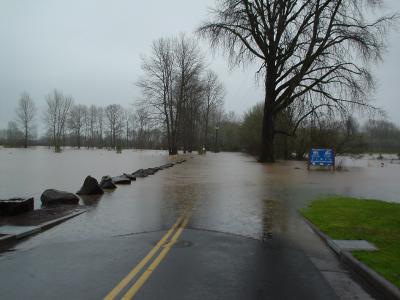Floods & High Water
Are You Prepared for a Flood?
The City of Corvallis annually updates a flood preparedness brochure as a reminder of the dangers related to heavy rainfall and the damage that can be caused when a flood occurs. We hope you will find information in this brochure that will help you.
Flooding In and Around Corvallis
The City of Corvallis Emergency Operation Plan (EOP) places the Corvallis Public Works Department as the lead agency for flooding in Corvallis. The Fire Department will assist Public Works with rescue, evacuation, and other assistance as may be required.
Historical Background
Local area flooding impacts can be projected based upon historical river levels. The following items occurred during a major flood (Willamette River level 32 feet):
- Mary's River completely overflowed its banks and covered South Third Street, completely dividing South Corvallis from the rest of the city.
- All roads east and west off Hwy 99W were closed due to flooding. Hwy 99W, north and south of the city, were passable for most vehicles.
- Hwy 34 and the Hwy 34 bypass were closed east of Corvallis.
- Hwy 20 to Albany remained open.
- Hwy 20/34, west to Philomath, remained open.
- Most phone lines and TV cable lines remained secure.
- Electricity delivery was stable.
- Fire Stations 1, 2, 3, and 6 were secure from flooding. Station 5 should be secure from flooding. Station 4 was threatened.
The following is a record of events during the December 1996 - January 1997 flood. All river readings are approximate and are based on visual readings taken from the VanBuren Street Bridge river level gauge. Local flooding of creeks and drainageways is independent of river readings, responding more to local rainfall than the Willamette River. (Mary's River is affected by both.)
Please note and understand that this information is what has occurred in the past and is offered here to help you assess your risk and plan for the future. It is in no way intended to guarantee that future flooding will occur in the same way.
| Willamette River Level | Road Accessibility |
|---|---|
| 29.5 Feet | Hwy 34 bypass was closed at the intersection with Hwy 34. Hwy 34 had water on or near the east bound fog line. |
| 29.7 Feet | Both east-bound lanes of Hwy 34 were covered with water. East-bound traffic was diverted to the median turning lane. Brooklane was closed to all traffic. |
| 30.0 Feet | Hwy 34 was down to one lane in each direction. |
| 30.1 Feet | Hwy 34 was covered with water; traffic was still allowed, one lane in each direction. |
| 30.5 Feet | Hwy 34 was closed to non-emergency traffic. Emergency vehicles were still allowed to pass. Terra Circle was closed to all traffic, Kiger Island was cut off. Two to four inches of water covered the west-bound lanes. |
| 30.9 Feet | Four to six inches of water covered the west-bound lanes of Hwy 34. Ambulances were allowed to ford if west-bound lanes were used. |
| 31.1 Feet | Twelve inches of water covered the west-bound lanes of Hwy 34, which were closed to ambulance traffic. |
| 31.3 Feet | South 3rd Street had water covering both outside lanes from mill race to Avery/Crystal Lake Drive. Both Avery & Crystal may have had water across. |
| 31.5 Feet | South 3rd Street at the mill race was just covered by water. Hwy 34 was closed to standard fire engines. |
| 32.0 Feet | Hwy 20 was closed at Garden Avenue. Hwy 20 was still accessible via Conifer Blvd. Hwy 34 was closed to all traffic, including fire equipment. |
After a Flood
Here are some links to information you may find useful in addressing sewage back-up or flooding in basements.
- CDC Recommendations for Flood Water After a Disaster or Emergency
- CDC Recommendations for Cleaning and Sanitizing With Bleach after an Emergency
- Repairing your Flood Damaged Home (Red Cross)
- A comprehensive publication on flood cleanup and home repairs (FEMA)
- A Brief Guide to Mold, Moisture and Your Home (EPA)
- FEMA webpage on flood cleanup
- Flood Clean up and the Air in Your Home (EPA) web page
- Flood Clean up and the Air in Your Home (EPA) booklet
Hydrated Lime – for outside use or crawl spaces
Hydrated lime is the cheapest of all disinfectants for use outside of the home. It also has the advantages of being odorless and safe to use. When mixed with eight to ten times its weight or four times its volume of water, milk of lime is obtained, which is very useful in the disinfection of feces. At least the same bulk of milk of lime as feces should be used. Milk of lime is also used as whitewash in dairy barns, where it is said to kill spores and sporeformers lodged in cracks. Lime is also a deodorant. When air slaked it is of no value. The indiscriminate scattering about of dry lime in open toilets, barns, etc. is of little or no use.
